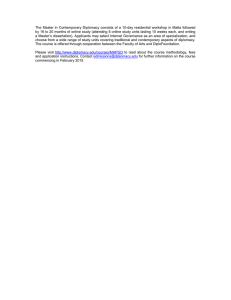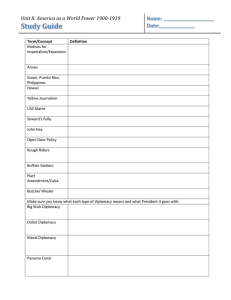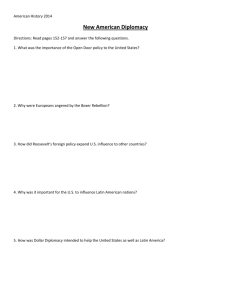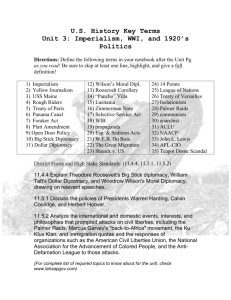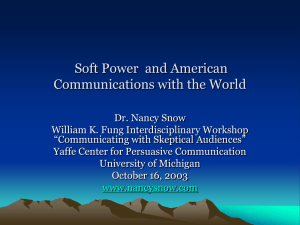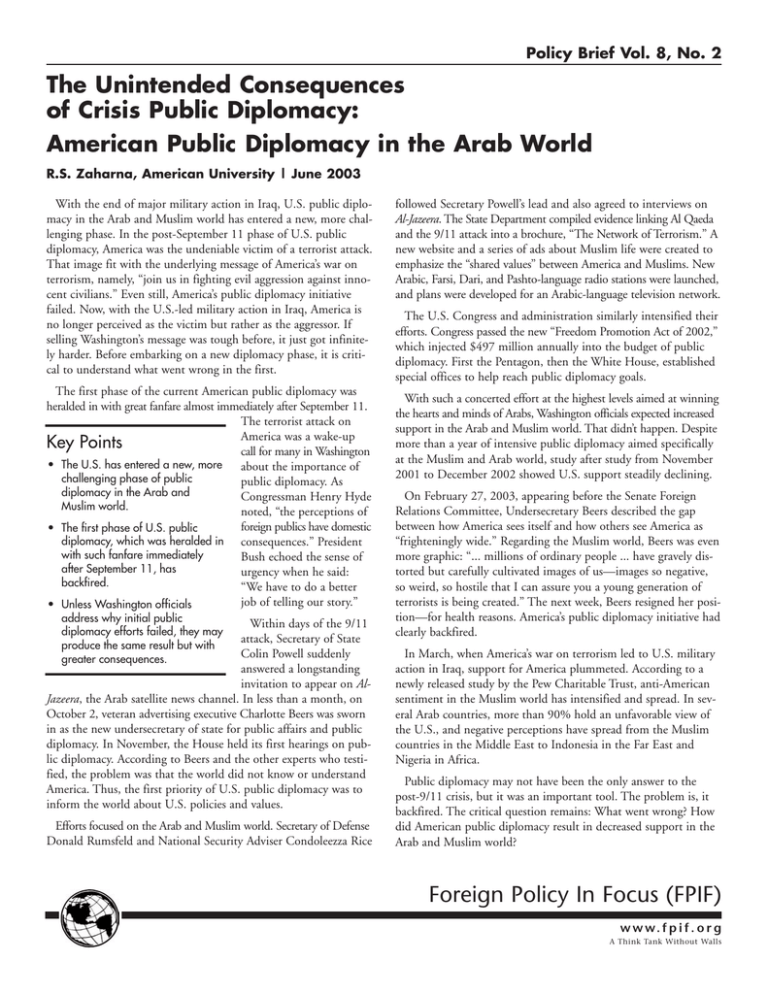
Policy Brief Vol. 8, No. 2
The Unintended Consequences
of Crisis Public Diplomacy:
American Public Diplomacy in the Arab World
R.S. Zaharna, American University | June 2003
With the end of major military action in Iraq, U.S. public diplomacy in the Arab and Muslim world has entered a new, more challenging phase. In the post-September 11 phase of U.S. public
diplomacy, America was the undeniable victim of a terrorist attack.
That image fit with the underlying message of America’s war on
terrorism, namely, “join us in fighting evil aggression against innocent civilians.” Even still, America’s public diplomacy initiative
failed. Now, with the U.S.-led military action in Iraq, America is
no longer perceived as the victim but rather as the aggressor. If
selling Washington’s message was tough before, it just got infinitely harder. Before embarking on a new diplomacy phase, it is critical to understand what went wrong in the first.
The first phase of the current American public diplomacy was
heralded in with great fanfare almost immediately after September 11.
The terrorist attack on
America was a wake-up
Key Points
call for many in Washington
• The U.S. has entered a new, more
about the importance of
challenging phase of public
public diplomacy. As
diplomacy in the Arab and
Congressman Henry Hyde
Muslim world.
noted, “the perceptions of
foreign publics have domestic
• The first phase of U.S. public
diplomacy, which was heralded in
consequences.” President
with such fanfare immediately
Bush echoed the sense of
after September 11, has
urgency when he said:
backfired.
“We have to do a better
job of telling our story.”
• Unless Washington officials
address why initial public
diplomacy efforts failed, they may
produce the same result but with
greater consequences.
Within days of the 9/11
attack, Secretary of State
Colin Powell suddenly
answered a longstanding
invitation to appear on AlJazeera, the Arab satellite news channel. In less than a month, on
October 2, veteran advertising executive Charlotte Beers was sworn
in as the new undersecretary of state for public affairs and public
diplomacy. In November, the House held its first hearings on public diplomacy. According to Beers and the other experts who testified, the problem was that the world did not know or understand
America. Thus, the first priority of U.S. public diplomacy was to
inform the world about U.S. policies and values.
Efforts focused on the Arab and Muslim world. Secretary of Defense
Donald Rumsfeld and National Security Adviser Condoleezza Rice
followed Secretary Powell’s lead and also agreed to interviews on
Al-Jazeera. The State Department compiled evidence linking Al Qaeda
and the 9/11 attack into a brochure, “The Network of Terrorism.” A
new website and a series of ads about Muslim life were created to
emphasize the “shared values” between America and Muslims. New
Arabic, Farsi, Dari, and Pashto-language radio stations were launched,
and plans were developed for an Arabic-language television network.
The U.S. Congress and administration similarly intensified their
efforts. Congress passed the new “Freedom Promotion Act of 2002,”
which injected $497 million annually into the budget of public
diplomacy. First the Pentagon, then the White House, established
special offices to help reach public diplomacy goals.
With such a concerted effort at the highest levels aimed at winning
the hearts and minds of Arabs, Washington officials expected increased
support in the Arab and Muslim world. That didn’t happen. Despite
more than a year of intensive public diplomacy aimed specifically
at the Muslim and Arab world, study after study from November
2001 to December 2002 showed U.S. support steadily declining.
On February 27, 2003, appearing before the Senate Foreign
Relations Committee, Undersecretary Beers described the gap
between how America sees itself and how others see America as
“frighteningly wide.” Regarding the Muslim world, Beers was even
more graphic: “... millions of ordinary people ... have gravely distorted but carefully cultivated images of us—images so negative,
so weird, so hostile that I can assure you a young generation of
terrorists is being created.” The next week, Beers resigned her position—for health reasons. America’s public diplomacy initiative had
clearly backfired.
In March, when America’s war on terrorism led to U.S. military
action in Iraq, support for America plummeted. According to a
newly released study by the Pew Charitable Trust, anti-American
sentiment in the Muslim world has intensified and spread. In several Arab countries, more than 90% hold an unfavorable view of
the U.S., and negative perceptions have spread from the Muslim
countries in the Middle East to Indonesia in the Far East and
Nigeria in Africa.
Public diplomacy may not have been the only answer to the
post-9/11 crisis, but it was an important tool. The problem is, it
backfired. The critical question remains: What went wrong? How
did American public diplomacy result in decreased support in the
Arab and Muslim world?
Foreign Policy In Focus (FPIF)
w w w. f p i f . o r g
A Think Tank Without Walls
Problems with Current U.S. Policy
The immediate explanation for declining Arab support for the U.S.
would appear to be America’s war on terrorism. But the whole purpose of
public diplomacy is to garner support for policies, even for unpopular
policies and even from skeptical foreign publics. To be effective,
public diplomacy must work not only in times of peace but also in times
of conflict. Two other factors loom much larger in explaining the failure
of public diplomacy in the Arab and Muslim worlds: credibility and culture.
The credibility problem derives from the fact that many in the
Middle East perceive a sharp contradiction between the words of
U.S. public diplomacy and the actions of U.S. foreign policy. This
discrepancy between America’s words and actions creates a credibility problem that can discredit even the best campaign.
The other key factor, which typically receives less emphasis, is
culture. Not all public diplomacy problems are communication
problems, but effective communication can help resolve policy and
credibility issues. The fact that Washington’s communication backfired with foreign audiences points to culture as the primary culprit. Different cultural styles of communicating often produce
opposite and unintended results.
Ironically, U.S. officials may have been so focused on studying their
audience’s culture that they neglected the influence of their own.
U.S. public diplomacy very much reflects a uniquely American
style of communication, public relations, and advertising. While
the American public responded positively to the style, the Arab
and Muslim publics, who have a different culture and style entirely, responded negatively or not at all. Several examples stand out.
First, U.S. public diplomacy focused on getting America’s message
out. This information-centered approach parallels the “information overload” syndrome found in America, where communication
problems are solved by the supply of information. The Arab world
has a more relationship-centered view of communication. Rather
than focusing on one-way message strategies to inform people, the
Arab culture tends to use two-way, relationship building strategies
to connect people. America’s information-centered goal resulted in a
flood of information that was neatly packaged but which failed to
connect with the Arab people.
Second, American public diplomacy relied heavily on the mass media
to get the U.S. message out to the most people in the least time. In
the Arab world, meeting people face to face may not be the most
efficient means of communicating, but it is the most effective, and
interpersonal channels are preferred. Besides, the Arab media does
not have a stellar history of credibility and trust with its public. Thus,
relying on the mass media to communicate with the Arab and Muslim
worlds is likely to prove both ineffective and counterproductive.
For example, Washington officials were repeatedly shocked by the
tenacity of rumors when the U.S. attacked the Taliban in Afghanistan.
Despite a rapid response team of U.S. spokespersons covering the news
cycle from Karachi to Washington, vicious rumors persisted. Rumors
speak to the advantage that social networks have over the media in spreading information; misperceptions speak to the advantage that interpersonal
communication has over mass communication regarding credibility.
p. 2
The State Department’s multi-milliondollar advertising campaign promoting Muslim life in America failed for the same reason. Television advertisements cannot compete with personal
phone calls from Muslims and Arabs in America about the immigration and discrimination problems they have faced in the U.S.
since September 11, 2001.
America’s style relied on facts and evidence as the primary persuasive tools in making the case against Saddam Hussein and Osama
bin Laden. For most Americans, the facts speak for themselves.
For most people in the Muslim world, impersonal facts ring hollow, while metaphors and analogies persuade. Not coincidentally,
the dominant persuasive devices found in the Holy Quran are
analogies, metaphors, and rhetorical questions. These are the tools
bin Laden wields so effectively.
Directness is another stylistic difference. President Bush’s penchant for “speaking straight” communicated a resolve that most
Americans cheered. In many Muslim countries, such directness in
public settings is perceived as confrontational, threatening the
recipient’s public face as well as its collective social fabric.
Finally, many of the
Key Problems
message appeals also
missed the mark. One out- • American public diplomacy is not
standing example was
culturally neutral but reflects a
Washington’s attempts to
uniquely American style of
show how the war on tercommunicating.
ror was not a war on Islam
• While the American style of
by emphasizing U.S.
communicating positively
efforts to help Muslims in
resonates with the American
Bosnia, Kosovo, and
pubic, it negatively resonates or
Afghanistan. Emphasizing
fails to resonate with the Arab
one’s good deeds is a covand Muslim publics.
eted practice in U.S. pub• Cultural differences in public
lic relations. Washington
communication styles undermined
officials were naturally
the effectiveness of American
confused and offended by
public diplomacy in the Arab and
apparent Muslim ingratiMuslim world.
tude. However, for most
Muslims, calling attention to one’s charity or good deeds is
frowned upon. The Quran admonishes, “cancel not your charity
by reminders of your generosity or injury.”
In general, U.S. officials appear to have overlooked culture as an
inherent feature of public diplomacy, viewing the problem as a
lack of information, and lamenting that “people don’t know about
us.” U.S. public diplomacy got the message out but had no control over how it was interpreted. In some cases, efforts by administration officials to explain U.S. policies were as offensive as the
policies themselves.
Since the American communication style elicits such a positive
response from the American public, Washington officials were at a
loss to explain why their best efforts were failing and the U.S.
image was spiraling downward.
www.fpif.org
A Think Tank Without Walls
Toward a New Foreign Policy
Culture, combined with the crisis America faced, produced the
unintended consequences of U.S. public diplomacy in the Arab
and Muslim world. The post-9/11 phase of U.S. public diplomacy
was, in effect, crisis public diplomacy. Unlike traditional public
diplomacy, which enjoys the luxury of time to cultivate favorable
publics individually, crisis public diplomacy entails communicating simultaneously with multiple audiences—including hostile
ones—in a rapidly changing, highly visible, and politically competitive communication environment.
American officials appeared to overlook the immediacy and glare
of the international media that crises engender. U.S. officials tried
to communicate with foreign publics as if they were separate from
the American public. Such
Key Recommendations
a distinction between foreign and domestic publics
• Culture, combined with crisis,
has become purely hypoproduced the unintended
thetical. In today’s global
consequences of U.S. public
and instantaneous comdiplomacy in the Arab and
Muslim world.
munication environment,
a nation can no longer
• The challenge of effective public
separate its domestic pubdiplomacy is bridging cultural
lic from foreign publics.
differences, so that an
What one hears, everyone
administration’s communication
hears.
style positively resonates with
domestic and foreign publics.
American efforts to
intensify its public diplomacy may have inadvertently magnified misunderstandings and tensions
between America and the
Arab and Muslim worlds.
Although both the domestic and foreign publics heard the same message, both interpreted it
differently. When America amplified its message through stronger
language and more vigorous dissemination, American domestic
support grew and foreign support weakened. The more America
intensified its public diplomacy efforts—using an American
style—the greater the gap became between the domestic and foreign publics.
• As the promise of U.S. liberators
fades into the reality of U.S.
occupiers in Iraq, the Arab world
conjures up highly negative and
emotionally charged images of
Israel’s military occupation of
Palestine.
This gap may have been widened by Washington’s need to gain
and solidify American domestic support. During times of conflict,
rallying domestic support often means identifying a foreign enemy.
If the foreign public identifies with the foreign enemy, efforts to
demonize the enemy only further alienate the foreign audience
and widen the gap between the domestic and foreign publics.
As the U.S. embarks on a new round of public diplomacy, the
challenge is how to span cultural barriers, so America’s public communication positively resonates with the domestic and foreign
publics. Meeting this challenge requires that U.S. officials not only
coordinate their message among America’s many spokespersons
but also harmonize communication with America’s many publics.
The two must go hand in hand.
p. 3
If there was a success in the first round of U.S. public diplomacy, achieving coordination was it. America’s initial public diplomacy
efforts highlighted the need for coordination. Disputes within the
administration were producing conflicting messages. However, by
the time the U.S. entered Iraq, all officials were speaking with one
powerful voice.
Now that the U.S. occupies Iraq, the problem of coordination has
reemerged. When the U.S. military entered Iraq, it became the new
face of American public diplomacy. U.S. troops are now both the
medium and the message of U.S. public diplomacy in the region.
In this respect, the U.S. military is at a distinct disadvantage.
The promise of America as a “liberator” is rapidly fading into the
reality of U.S. troops as “occupiers.” Americans tend to have a historically positive view of military occupation; the U.S. occupation
of Germany and Japan helped transform both into world economic powers. In the Arab and Muslim world, military occupation
conjures up highly negative and emotionally charged images of the
Israeli military occupation of Palestinian land. These images are
fertile ground for rumors, stereotypes, and fears. Already one can
substitute photo captions from the U.S. military occupation in
Iraq, such as the walking patrols and checkpoints, with those of
the Israeli military occupation in Gaza. The more entrenched
these images become, the more difficult they will be to remove
later.
American credibility, matching words about Iraq with deeds in
Iraq, will be closely monitored. Given the presence of U.S. troops, it
is important that the Bush administration’s public statements correspond to the actual situation in Iraq. Credibility and public
diplomacy effectiveness will not be measured by mass media efficiency but rather by the tenor of the personal stories circulating during
the evening social visits among Iraqi families and neighbors.
Harmonizing America’s communication with its internal and
external publics will be equally challenging and will require large
doses of cultural awareness. The effort to be more culturally
attuned will entail fewer Washington-driven initiatives that sound
good at home and more field-driven initiatives that work well
abroad. Also, implementing some of the institutional recommendations proposed by the Council on Foreign Relations and the
U.S. Information Agency Alumni Association may help make U.S.
public diplomacy more responsive, flexible, and proactive in the
region. Through a dual approach—coordinating communication
internally and harmonizing it externally—U.S. officials can avoid
the unintended consequences of crisis public diplomacy.
R.S. Zaharna <zaharna@american.edu> is a Middle East analyst for Foreign Policy In Focus (online at www.fpif.org) and an
assistant professor of public communication at American
University. She specializes in international and intercultural
communication.
www.fpif.org
A Think Tank Without Walls
Sources for More Information
Websites
DiploFoundation
http://www.diplomacy.edu/
GlobalPac: Supporting Public Diplomacy
http://www.globalpac.org/
Public Diplomacy Web Site (sponsored by U.S. Information Agency
Alumni Association and The Public Diplomacy Council)
http://www.publicdiplomacy.org/
U.S. Advisory Commission for Public Diplomacy
http://www.state.gov/r/adcompd/
Council on Foreign Relations, “Public Diplomacy: A Strategy for
Reform,” A Report of an Independent Task Force on Public
Diplomacy, Peter G. Peterson, Chairman, Washington, July 30, 2002,
available at http://www.cfr.org/publication.php?id=4682
Parag Khanna, “America in the Age of Geodiplomacy,” Georgetown
Journal of International Affairs, Winter/Spring 2003, available at
http://journal.georgetown.edu/Issues/ws03/khannalocked.pdf
Mark Leonard and Conrad Smewing, Public Diplomacy and the Middle
East, The British Council (Foreign Policy Centre, London, February
2003), available at http://fpc.org.uk/reports/
U.S. Department of State, “Public Diplomacy After September 11:
Shared Values Collage”
http://www.state.gov/r/pa/obs/vid/16555.htm
The Pew Research Center for People and the Press, “Views of a
Changing World 2003: War with Iraq Further Divides Global Publics,”
June 3, 2003, available at http://people-press.org/reports/
display.php3?ReportID=185
U.S. Department of State, “Muslim Life in America” (website)
http://usinfo.state.gov/products/pubs/muslimlife/
USIA Alumni Association, “Making Public Diplomacy Effective,” May
28, 2003, available at http://www.publicdiplomacy.org/17.htm
U.S. Department of State, “The Network of Terrorism” (brochure)
http://usinfo.state.gov/products/pubs/terrornet/
U.S. Advisory Commission on Public Diplomacy, “Consolidation of
USIA into the State Department: An Assessment After One Year,”
October 2000, available at http://www.state.gov/www/policy/
pdadcom/acpdreport.pdf
Voice of America
http://www.voa.gov/
Publications
Charlotte Beers, Undersecretary of State for Public Diplomacy,
“American Public Diplomacy and Islam,” Testimony before Senate
Foreign Relations Committee, February 27, 2003, available at
http://foreign.senate.gov/hearings/hrg030227a.html
John Brown, “The Purposes and Cross-Purposes of Public Diplomacy,”
American Diplomacy, August 15, 2002. Available at
http://www.unc.edu/depts/diplomat/archives_roll/2002_07-09/
brown_pubdipl/brown_pubdipl.html
R.S. Zaharna, “Asymmetry of Cultural Styles & The Unintended
Consequences of Crisis Public Diplomacy,” in Intercultural
Communication and Diplomacy, Editor: Mediterranean Academy of
Diplomacy, Malta (forthcoming), available at http://www.diplomacy.edu/
R.S. Zaharna, “American Public Diplomacy and Islam,” Testimony before
Senate Foreign Relations Committee, February 27, 2003, available at
http://foreign.senate.gov/hearings/ZaharnaTestimony030227.pdf
R.S. Zaharna, “American Public Diplomacy and the Arab and Muslim
Worlds: A Strategic Communication Analysis,” available at
http://www.fpif.org/papers/communication.html
R.S. Zaharna, “Finding America’s Voice in the Middle East,” available
at http://www.fpif.org/commentary/2002/0204usmideast.html
Published by Foreign Policy In Focus (FPIF), a joint project of the Interhemispheric Resource Center (IRC, online at www.irc-online.org) and the
Institute for Policy Studies (IPS, online at www.ips-dc.org). ©2003. All rights reserved.
Foreign Policy In Focus
“A Think Tank Without Walls”
Foreign Policy in Focus is a joint project of the Interhemispheric Resource Center (IRC) and the Institute for Policy Studies (IPS). The project depends on
sales and subscription income, individual donors, and grants from foundations and churches. In Focus internships are available, and we invite article
queries and comments.
ISSN 1524-1939
Recommended citation:
R.S. Zaharna, “The Unintended Consequences of Crisis Public Diplomacy: American Public Diplomacy in the Arab World,” (Silver City, NM &
Washington, DC: Foreign Policy In Focus, June 2003).
Web location:
http://www.fpif.org/briefs/vol8/v8n02diplomacy.html
Production Information:
Writer:
Editors:
Layout:
R.S. Zaharna
John Gershman, IRC
Emira Woods, IPS
Tonya Cannariato, IRC
p. 4
w w w. f p i f . o r g
A Think Tank Without Walls
Media Officer: Emily Schwartz, IPS

